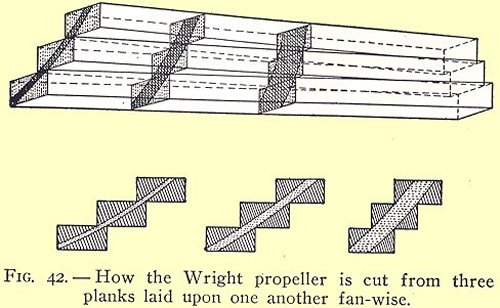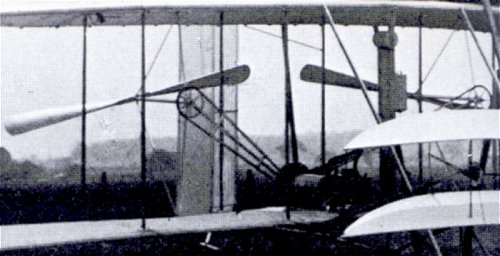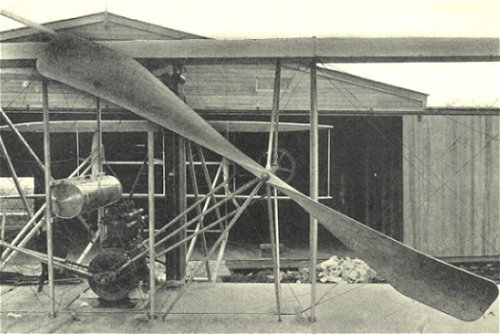The Wright Brothers' Propellers
Today, the Wright Brothers' propellers. The University of Houston's College of Engineering presents this series about the machines that make our civilization run, and the people whose ingenuity created them.
This Wednesday, December seventeenth, 2003, marks one century since the Wright Brothers' famous flight. I thought there'd be nothing more to say about it when I found a recent article by three engineers who've studied the propellers of the first Wright Flyer.
Two eight-foot diameter propellers pushed (rather than pulled) the airplane forward. They were made of laminated spruce and a sprocket-driven bicycle chain drove them. Power was supplied by a twelve-horsepower, four-cylinder, homemade engine -- the first internal combustion engine to be made of cast aluminum.
We look at those propellers and hardly see them. Indeed, if we do see them, they strike us as uninteresting. They look like narrow sticks, widening slightly toward their flat tips. And yet, like the rest of the airplane, they represent a huge departure from anything that'd been made before them.
Propellers had only recently been put to use driving ships. But the dynamics of a propeller in water are much different than in air. Water has a thousand times the density of air. In water, one must avoid arranging the flow to give a low pressure anywhere on the blade. That leads to cavitation, which attacks the surface of a ship's propeller.
The Wrights knew they had to get maximum thrust from a very small engine. They settled on a propeller design with an airfoil cross-section. They twisted its blade so the pitch was high near the hub where it moved slowly, and lower out at the tip.
Then they tested a reduced-scale model, measuring the propeller's rpm and thrust. When they were done, they had performance curves. They knew each propeller would provide 67 pounds of thrust at thirty miles an hour -- enough to get the job done.
But they'd also learned enough so they could change the propeller speed to meet different flying conditions. Their primitive engine had no throttle; it operated only at one speed. However, they could change the propeller speed by switching out the sprockets between flights.
Now the authors of this new article reconstruct the Wright propellers from old records, and from fragments of the original propellers. They do wind tunnel tests. The Wrights weren't able to test propellers in their small tunnel. They could only predict how the propellers would act in forward motion.
In the end, computer modeling shows that the Wright's propeller design was almost optimal for their low airspeeds. Old photos of propellers from the not-quite-successful airplanes of people like Samuel P. Langley, Gustave Whitehead, and Hiram Maxim all show the same primitive flaring triangular shape. Those airplane-makers were nowhere close to their contemporaries, the Wright Brothers.
And so, while people try to challenge the Wright Brothers' priority, the vast base of solid engineering continues to tilt in their favor -- detail by detail. Did they invent the airplane? Oh yes indeed. I think we can safely say they really did.
I'm John Lienhard, at the University of Houston, where we're interested in the way inventive minds work.
(Theme music)
R. A. Ash, C. P. Britcher, and K. W. Hyde, Prop-Wrights: How Two Brothers from Dayton Added a New Twist to Airplane Propulsion. Mechanical Engineering (100 Years of Flight Supplement), Dec. 2003, pp. 11-15, 39.

From Kaempffert, The New Art of Flying, 1910.

Detail from a 1904 photo, showing original form of Wright propellers (Library of Congress)

A later form of Wright propellers (Kaempffert, 1910)
Note Added on March 25, 2016 (Original episode ran at the end of 2003.): Bernard Biales, a student of the Wright Brother's design process, writes about the Wright Brother's expections of their design and the actual performance. He wonders what they really did expect. He says.
"The Wright propeller development program discussed in your brief article is a fascinating story. However, there a few points that need reevaluation. One is the statement that the props generated 67 lb each at 30 mph. Would that it were so. The AIAA tunnel tests showed their combined thrust to be about 100 lb (that was at 42 fps and 340 rpm: it would be a little more at 348 rpm and 44 fps and the Dec. 17 ambient atmosphere -- say around 110 lb). Also, simple calculation -- the engine at pretty close to 12 HP output shaft, and 11.4 HP for the propeller input shafts, works out to nearly 6300 ft-lb/sec. My current estimate is that the prop efficiency was around 73%, which gives around 4600 ft-lb/sec or just over 100 lb thrust at 44 fps. You allude to the question of static vs dynamic thrust. It is true that the Wrights said that you can't project the dynamic (or unstalled propeller) thrust from the static thrust. This makes it passing strange that they were encouraged by the static tests at Kitty Hawk in Nov. 1903. I suspect, based on the fact that they had data for airfoils at high angles of attack, that they might have been able to come up with at least a rough static number, but I have no idea whether they actually attempted such a calculation. If they did it, it is not in the papers.
Note too that the Wright's estimate of 66% efficiency did not include transmission losses, which were about 5 per cent. This gets further into the whole rats nest of what they expected and what the plane actually did, including their estimate of 24 mph minimum sustainable speed.
I would add one peripheral point. The Wright's competitor, Samuel Pierpoint Langley's engine was so powerful that he hardly needed a good propeller. What he really needed was a good airplane (and a trained pilot)!"